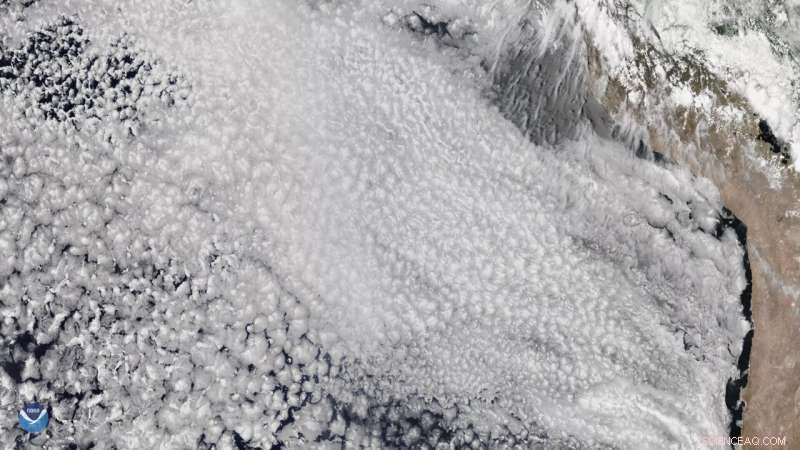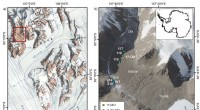En skyfri fremtid? Mysteriet i hjertet af klimaprognoser

Lavvandede skyer dannet af finskala hvirvler som observeret i naturen. Forskere bruger avanceret databehandling til at tilføje skydynamik med højere opløsning til globale simuleringer. Kredit:Creative commons
Vi hører meget om, hvordan klimaændringer vil ændre land, hav og is. Men hvordan vil det påvirke skyer?
"Lave skyer kan tørre op og skrumpe som iskapperne," siger Michael Pritchard, professor i Earth System science ved UC Irvine. "Eller de kunne blive tykkere og blive mere reflekterende."
Disse to scenarier ville resultere i meget forskellige fremtidige klimaer. Og det, siger Pritchard, er en del af problemet.
"Hvis du spørger to forskellige klimamodeller, hvordan fremtiden vil se ud, når vi tilføjer meget mere CO2 , får du to meget forskellige svar. Og hovedårsagen til dette er den måde, skyer er inkluderet i klimamodeller."
Ingen benægter, at skyer og aerosoler - stumper af sod og støv, der danner kerne af skydråber - er en vigtig del af klimaligningen. Problemet er, at disse fænomener opstår på en længde- og tidsskala, som nutidens modeller ikke kan komme i nærheden af at gengive. De indgår derfor i modeller gennem en række forskellige tilnærmelser.
Analyser af globale klimamodeller viser konsekvent, at skyer udgør den største kilde til usikkerhed og ustabilitet.
Retooling community-koder
Mens den mest avancerede amerikanske globale klimamodel kæmper for at nærme sig 4 kilometer global opløsning, vurderer Pritchard, at modeller har brug for en opløsning på mindst 100 meter for at fange de finskala turbulente hvirvler, der danner lavvandede skysystemer - 40 gange mere opløst i hver retning. Det kan tage indtil 2060, ifølge Moores lov, før computerkraften er tilgængelig til at fange dette detaljeringsniveau.
Pritchard arbejder på at rette op på dette iøjnefaldende hul ved at dele klimamodelleringsproblemet i to dele:en grovkornet planetarisk model med lavere opløsning (100 km) og mange små pletter med en opløsning på 100 til 200 meter. De to simuleringer kører uafhængigt af hinanden og udveksler derefter data hvert 30. minut for at sikre, at hverken simulering går af sporet eller bliver urealistisk.
Hans team har rapporteret resultaterne af disse bestræbelser i Journal of Advances in Modeling Earth Systems i april 2022.
Denne klimasimuleringsmetode, kaldet en "Multiscale Modeling Framework (MMF)," har eksisteret siden 2000 og har længe været en mulighed inden for Community Earth System Model-modellen (CESM), udviklet ved National Center for Atmospheric Research. Idéen har på det seneste fået en renæssance på Institut for Energi, hvor forskere fra Energy Exascale Earth System Model (E3SM) har skubbet den til nye beregningsmæssige grænser som en del af Exascale Computing Project. Pritchards medforfatter Walter Hannah fra Lawrence Livermore nationale laboratorium hjælper med at lede denne indsats.
"Modellen afslutter det sværeste problem - modellering af hele planeten," forklarede Pritchard. "Den har tusindvis af små mikromodeller, der fanger ting som realistisk lavvandet skydannelse, der kun dukker op i meget høj opløsning."
"Multiscale Modeling Framework-tilgangen er også ideel til DOE's kommende GPU-baserede exascale-computere," sagde Mark Taylor, Chief Computational Scientist for DOE's Energy Exascale Earth System Model (E3SM)-projekt og en forsker ved Sandia National Laboratories. "Hver GPU har hestekræfterne til at køre hundredvis af mikromodellerne, mens de stadig matcher gennemløbet af den grovkornede planetariske model med lavere opløsning."
Pritchards forskning og nye tilgang er delvist muliggjort af den NSF-finansierede Frontera supercomputer ved Texas Advanced Computing Center (TACC). Pritchard, den hurtigste universitetssupercomputer i verden, kan køre sine modeller på Frontera i en tids- og længdeskala, der kun er tilgængelig på en håndfuld systemer i USA, og teste deres potentiale for cloud-modellering.
"Vi udviklede en måde, hvorpå en supercomputer bedst kan opdele arbejdet med at simulere skyfysikken over forskellige dele af verden, der fortjener forskellige mængder opløsning... så den kører meget hurtigere," skrev teamet.
Simulating the atmosphere in this way provides Pritchard the resolution needed to capture the physical processes and turbulent eddies involved in cloud formation. The researchers showed that the multi-model approach did not produce unwanted side effects even where patches using different cloud-resolving grid structures met.
"We were happy so see that the differences were small," he said. "This will provide new flexibility to all users of climate models who want to focus high resolution in different places."
Disentangling and reconnecting the various scales of the CESM model was one challenge that Pritchard's team overcame. Another involved reprogramming the model so it could take advantage of the ever-increasing number of processors available on modern supercomputing systems.
Pritchard and his team—UCI postdoctoral scholar Liran Peng and University of Washington research scientist Peter Blossey—tackled this by breaking the inner domains of the CESM's embedded cloud models into smaller parts that could be solved in parallel using MPI, or message passing interface—a way of exchanging messages between multiple computers running a parallel program across distributed memory—and orchestrating these calculations to use many more processors.
"Doing so seems to already provide a four-time speed-up with great efficiency. That means, I can be four times as ambitious for my cloud-resolving models," he said. "I'm really optimistic that this dream of regionalizing and MPI decomposing is leading to a totally different landscape of what's possible."
Machine learning clouds
Pritchard sees another promising approach in machine learning, which his team has been exploring since 2017. "I've been very provoked by how performantly a dumb sheet of neurons can reproduce these partial differential equations," Pritchard said.
Pritchard's research and new approach is made possible in part by the NSF-funded Frontera supercomputer at TACC. The fastest university supercomputer in the world, Pritchard can run his models on Frontera at a time and length-scale accessible only on a handful of systems in the U.S. and test their potential for cloud modeling.
In a paper submitted last fall, Pritchard, lead author Tom Beucler, of UCI, and others describe a machine learning approach that successfully predicts atmospheric conditions even in climate regimes it was not trained on, where others have struggled to do so.
This "climate invariant" model incorporates physical knowledge of climate processes into the machine learning algorithms. Their study—which used Stampede2 at TACC, Cheyenne at the National Center for Atmospheric Research, and Expanse at the San Diego Supercomputer Center—showed the machine learning method can maintain high accuracy across a wide range of climates and geographies.
"If machine learning high-resolution cloud physics ever succeeded, it would transform everything about how we do climate simulations," Pritchard said. "I'm interested in seeing how reproducibly and reliably the machine learning approach can succeed in complex settings."
Pritchard is well-positioned to do so. He is on the Executive Committee of the NSF Center for Learning the Earth with Artificial Intelligence and Physics, or LEAP—a new Science and Technology Center, funded by NSF in 2021 directed by his long-time collaborator on this topic, Professor Pierre Gentine. LEAP brings together climate and data scientists to narrow the range of uncertainty in climate modeling, providing more precise and actionable climate projections that achieve immediate societal impact.
"All of the research I've done before is what I would call 'throughput-limited.'" Pritchard said. "My job was to produce 10- to 100-year simulations. That constrained all my grid choices. However, if the goal is to produce short simulations to train machine learning models, that's a different landscape."
Pritchard hopes to soon use the results of his 50 meter embedded models to start building up a large training library. "It's a really nice dataset to do machine learning on."
But will AI mature fast enough? Time is of the essence to figure out the destiny of clouds.
"If those clouds shrink away, like ice sheets will, exposing darker surfaces, that will amplify global warming and all the hazards that come with it. But if they do the opposites of ice sheets and thicken up, which they could, that's less hazardous. Some have estimated this as a multi-trillion dollar issue for society. And this has been in question for a long time," Pritchard said.
Simulation by simulation, federally-funded supercomputers are helping Pritchard and others approach the answer to this critical question.
"I'm torn between genuine gratitude for the U.S. national computing infrastructure, which is so incredible at helping us develop and run climate models," Pritchard said, "and feeling that we need a Manhattan Project level of new federal funding and interagency coordination to actually solve this problem."
 Varme artikler
Varme artikler
-
 Hvem ejer havene?Et par af oceanernes ejere nyder stranden på Comorerne, en skærgård i Det Indiske Ocean. Se flere billeder af smukke strande. Jose Cendon/AFP/Getty Images Hvem ejer verdenshavene? Det er et legitimt
Hvem ejer havene?Et par af oceanernes ejere nyder stranden på Comorerne, en skærgård i Det Indiske Ocean. Se flere billeder af smukke strande. Jose Cendon/AFP/Getty Images Hvem ejer verdenshavene? Det er et legitimt -
 Iskerne taget i Antarktis indeholder prøve af atmosfære fra fem millioner år sidenPlacering af Ong Valley. (a) Beskåret USGS 1:250 000 topografisk kort over Miller Range, Antarktis, der viser placeringen af Ong Valley. Det røde rektangel angiver placeringen af Ong-dalen, der åb
Iskerne taget i Antarktis indeholder prøve af atmosfære fra fem millioner år sidenPlacering af Ong Valley. (a) Beskåret USGS 1:250 000 topografisk kort over Miller Range, Antarktis, der viser placeringen af Ong Valley. Det røde rektangel angiver placeringen af Ong-dalen, der åb -
 Jordskælv med en styrke på 6,4 rammer det vestlige Iran:Iran InstituteDer var rapporter om, at et jordskælv med en styrke på 6,4 i det vestlige Iran den 25. 2018, kunne også mærkes på tværs af grænsen i Irak Et kraftigt jordskælv med en styrke på 6,4 ramte Irans ves
Jordskælv med en styrke på 6,4 rammer det vestlige Iran:Iran InstituteDer var rapporter om, at et jordskælv med en styrke på 6,4 i det vestlige Iran den 25. 2018, kunne også mærkes på tværs af grænsen i Irak Et kraftigt jordskælv med en styrke på 6,4 ramte Irans ves -
 Når bionedbrydelig plast ikke er biologisk nedbrydeligDenne biologisk nedbrydelige plastikpose havde masser af liv tilbage i sig, selv efter tre år. Lloyd Russell/University of Plymouth. Kredit:University of Bath Ideen om en biologisk nedbrydelig pla
Når bionedbrydelig plast ikke er biologisk nedbrydeligDenne biologisk nedbrydelige plastikpose havde masser af liv tilbage i sig, selv efter tre år. Lloyd Russell/University of Plymouth. Kredit:University of Bath Ideen om en biologisk nedbrydelig pla
- Plastikspisende enzymcocktail indvarsler nyt håb for plastikaffald
- Rytmiske svingninger påvist i blazaren Markarian 501
- Forskere skaber perfekte nanoscrolls fra grafenes ufuldkomne form
- To-vejs signalering mulig med en enkelt kvantepartikel
- Hvad betyder en hygrometermåling?
- Problem med ny amerikansk vejrsatellit kan påvirke billeder (Opdatering)


